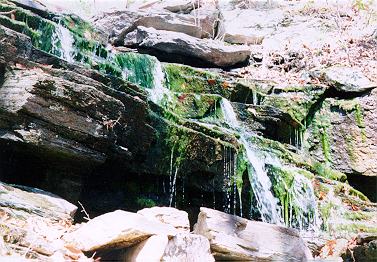

You are a member of the Board of Health of your town. You have been called by an acquaintance in town and told that they have noticed the underground gasoline tanks being dug up at the local service station. The service station owner told them the tanks are being replaced because of a "small" leak discovered in one of the tanks.Your acquaintance's residence is located less than half a mile downhill from the service station. Since they rely on a drinking-water well on their property for water, they are wondering weather there is a health risk they should be aware of. After a discussion, the Board of Health decides to contact the town engineer and ask her to investigate the situation. The town engineer employs mathematical models of ground water migration, travel time, and contaminant concentration to reach the following conclusions:
The figure below gives the general layout of the land, with X marking the location of the service station and W3 marking the location of your acquaintance's well. W1 and W2 are drinking-water wells on neighboring properties. The ground water migration path, marked by a bold arc on the figure shows that the path will indeed pass through your acquaintance well.
![]() Can you
figure out why?
Can you
figure out why?
The table below the figure gives the ground water travel-time
calculations done with Microsoft Excel spreadsheet program. The conclusion
is that it will take 2.42 years for the contaminated ground water to reach
well W3. This seems like good news as it leaves enough time to attempt
cleaning procedures.

| Conductivity = | 50 | ft/day | |||||
| porosity = | 0.25 | ||||||
| Segment | Length | h1 | h2 | I | v(ft/day) | t(days) | t(years) |
| 1 | 170 | 0.011 | 2.2 | 78.2 | 0.21 | ||
| 2 | 460 | 85 | 80 | 0.011 | 2.2 | 211.6 | 0.58 |
| 3 | 530 | 80 | 75 | 0.009 | 1.9 | 280.9 | 0.77 |
| 4 | 440 | 75 | 70 | 0.011 | 2.3 | 193.6 | 0.53 |
| 5 | 270 | 0.011 | 2.3 | 118.8 | 0.33 | ||
| Total | 883.1 | 2.42 |
Since you have taken a mathematical modeling in the environment course in college you are aware of the main issues involved in the modeling procedure. For example, you know that most likely the travel-time calculations were carried out using available conductivity and porosity values for the aquifer in the region. You advise your acquaintance to insist on new calculations being conducted with more accurate local-specific conductivity and porosity values. A small change in these parameters may mean the contaminated ground water will reach their well sooner. For good measure, you also advise them to contact a lawyer.
![]()
Back to Math 108V Poster's Main Page